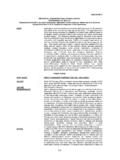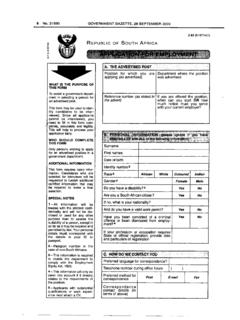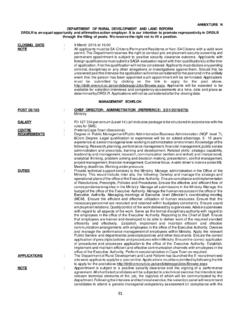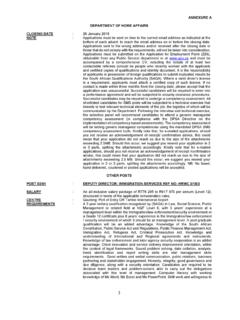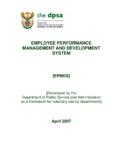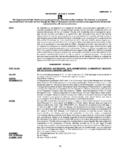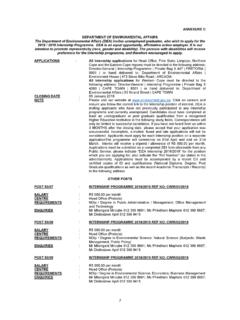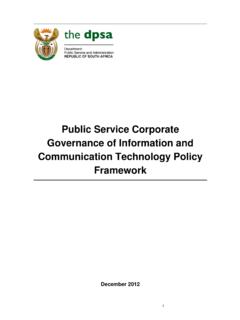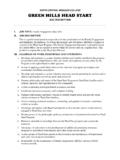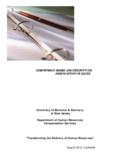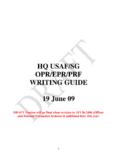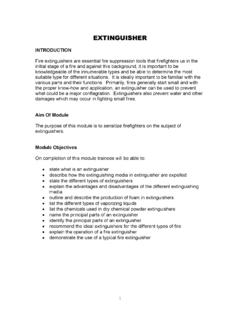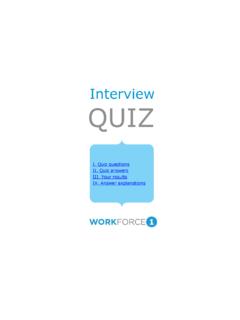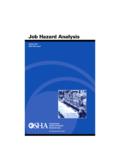Transcription of GUIDE ON JOB DESCRIPTIONS - the dpsa
1 1 99070705/arnold/mg GUIDE ON JOB DESCRIPTIONS 1 99070705/arnold/mg GUIDE ON JOB DESCRIPTION TABLE OF CONTENTS Page PART I: INTRODUCTION A. Purpose of the GUIDE 2 B. Approach followed by the GUIDE 2 C. Rationale for job description 3 PART II: SUGGESTED JOB DESCRIPTION MODEL A. Job information summary 4 B. Job Purpose 4 C. Main Objectives 5 D. Inherent requirements of the job 5 E. Career pathing 7 PART III: MANAGING JOB DESCRIPTIONS IN A DEPARTMENT A.
2 Practical advice 9 2 99070705/arnold/mg PART I: INTRODUCTION A. PURPOSE OF THE GUIDE The GUIDE on Job Description ( GUIDE ) aims to advise departments about the compilation and utilisation of job DESCRIPTIONS in accordance with their needs and circumstances. Although the GUIDE itself is advisory, the new Public Service Regulations(PSR) prescribe that departments must compile job DESCRIPTIONS for each post and/or group of posts. The intention is that the GUIDE should be as useful, relevant and user-friendly as possible. Any feedback, including examples of best practice, would be appreciated in order to update and improve it periodically. Inputs should be submitted to the Department of Public Service and Administration. B. APPROACH FOLLOWED BY THE GUIDE The GUIDE takes into account the requirements of PSR that job DESCRIPTIONS should be based on the main objectives of jobs, should indicate the inherent requirements of jobs, and reflect an appropriate emphasis on service delivery.
3 Certain information about career pathing is also required. Furthermore, the specific model which has been developed to assist departments and which is discussed in Part II of the GUIDE , takes into consideration the needs of the EQUATE job evaluation system which is prescribed for the public service, as well as the requirements set out with regard to service delivery, performance management and various human resource management practices. The latter are indicated in the Batho Pele White Paper and the White Papers on Human Resource Management and Public Service Education and Training respectively. With the phasing out of the Personnel Administration Standard (PAS) system and the introduction of the Codes of Remuneration (CORE) the need for job description as an integral part of work organisation and job design should become more apparent in practice. The impact of the CORE on work organisation is that a much more flexible approach can be adopted towards job design which may cut across the narrow and rigid definitions of work previously prescribed in the PAS.
4 Multi-tasking, as well as the merging of job responsibilities to promote service delivery, will also be possible with the implementation of the new regulatory framework. Whereas job DESCRIPTIONS have traditionally focussed on the job content of posts, the suggested model focuses on the objectives as well as the job outputs and competencies (skills, knowledge) which are required to perform them successfully at the various post levels. By linking output (job specification) with competency (person specification) job DESCRIPTIONS can serve as an important source of job information as well as a strategic management tool within an organisation. 99070705/arnold/mg 3 99070705/arnold/mg 4 C. RATIONALE FOR JOB DESCRIPTIONS Public Service Regulations prescribe that all departments must compile job DESCRIPTIONS and job titles for each post and/or group of posts. As a multipurpose source of job information, job DESCRIPTIONS and job titles should be completed to assist job evaluation as well as the advertising and filling of posts.
5 The regulations require job DESCRIPTIONS essentially - to encourage managers and employees to develop a more consistent understanding of the responsibilities attached to a post. to ensure that all employees have a defined career path, and to encourage departments to review employees responsibilities to ensure that they align with departmental objectives. But job DESCRIPTIONS may lead to excessive rigidity, so that employees refuse all tasks not included in their job description. For this reason, departments must ensure that job DESCRIPTIONS explicitly permit related tasks, even if they are not specified, and avoid excessive detail. D. AMENDMENT OF JOB DESCRIPTIONS AND JOB TITLES Job DESCRIPTIONS and titles may have a substantial impact on conditions of service and negotiations. To institute a new job title and description, a department may explicitly de-link a job from the former PAS.
6 The department will then have to negotiate a new employment contract with the employee, which could affect grading and eligibility for rank or leg promotions. This approach is advisable only where a department is designing a fairly unique job. If does not make sense where employees form part of large national cohorts subject to sectoral bargaining, for instance, health personnel or where a law requires a particular title, for instance, for district surgeons. A department may explicitly maintain the link between a job and the former PAS, which will mean that no change occurs in the employee s conditions of service even if the job description or title is modified. 4 99070705/arnold/mg PART II: SUGGESTED JOB DESCRIPTION MODEL A job description model has been developed to assist departments in developing their own models. Depending on their individual needs and circumstances departments may need to manage and structure their job DESCRIPTIONS differently.
7 The suggested model does however take into account the requirements of the PSR as well as relevant human resource practices requirements and should therefore serve as a useful GUIDE . It consists of the following components: A. JOB INFORMATION SUMMARY A summary of job details provides a useful and short source of job information which can assist organisation planning and related processes. It should include the following: Name of the current postholder Job title/job category title - depending on whether an individual post or group of posts is being described. Departments and provincial administrations must determine job titles based on the main objectives of posts in terms of PSR and the Occupational Classification System; CORE - the CORE applicable to the occupational category in respect of which the post(s) has/ have been created; Grade and the salary attached to the post - as determined by means of the job evaluation system in conjunction with the applicable CORE; The name of the component in which the post(s) is/ are located; Organisational placement (a simplified organogram could be attached) - the position of the post in the organisation structure also indicating the next higher post the incumbent reports to for organisation purposes as well as direct subordinates; Location (the name of the city/town in which the post(s) is/are located); The date on which the job description is completed/reviewed.
8 B. JOB PURPOSE (Reason why post was created) The job purpose is an accurate, short statement about the post s or post category's overall purpose or reason for existence in a department. It also serves to give some indication about how a job can be linked to the organisational mission and objectives. Details about how the job purpose will be achieved should not be included. (This part relates closely to the main objectives discussed below and it can be considered not to indicate it seperately but to integrate it as part of the main 99070705/arnold/mg 5 objectives). Examples: ELEMENTARY JOB (FARM AID I) COMPLEX JOB (SENIOR HR PRACTITIONER) Support agricultural research that aims to identify and register new plant varieties. Give direction to and co-ordinate the development and application of human resource policies in the department. C. MAIN OBJECTIVES (Goals to be achieved) Traditionally, job DESCRIPTIONS gave lists of duties, tasks or activities.
9 The regulations indicate a shift to describing the objectives of the job. Instead of trying to control the work process, supervisors can then assess outputs. This approach seeks to give employees greater freedom to define the most efficient, effective and meaningful way of doing their work. A job description should list five or six main objectives, which are goals that must be achieved to fulfil the overall purpose of the job. As far as possible, it should state objectives in terms of measurable results and rank them in order of importance. It should not include details about how a job should be done. The main objectives of a post should be worded in such a way that the level of work which is being performed by the incumbent of a specific post can be clearly identified. Management and supervisory responsibilities should also be reflected. Examples: ELEMENTARY JOB (FARM AID I) COMPLEX JOB (SENIOR HR PRACTITIONER) 1.
10 Clearly demarcated and well-prepared land. 1. A relevant and updated action plan for the development of departmental HRM policies. 2. Well planted and irrigated crops. 2. Policy inputs reviewed and analysed in accordance with the action plan. 3. Properly recorded research data. 3. Co-ordination and collaboration throughout the Department in developing HRM policies according to the timetable in the action plan. 4. Well fertilised and weeded land. 4. Correct application of HRM policies through support and monitoring in accordance with the action plan. 5. Properly harvested crops. 5. A stronger HRM capacity thanks to the provision of information, guidance, assistance and training to HRM component, line managers and others. D. INHERENT REQUIREMENTS OF THE JOB (Competency profile) The inherent requirements of a job refer to the competencies that, according to 99070705/arnold/mg 6 evidence, an employee needs in order to carry out a job.
